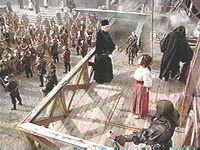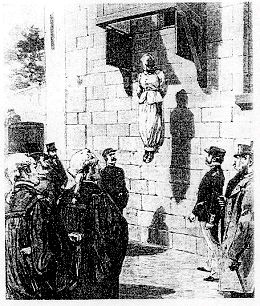 |
 |
The gallows
 |
 |
A tree was the earliest form of gallows with prisoner being either hauled
up manually by the hangman or turned off from a ladder or a cart. There
are still some hanging trees in existence - there is one at
Weeping Cross in Stafford. Two trees with a beam between them formed
the gallows for Mary
Blandy's execution at Oxford in 1752 when she uttered the famous words
"for the sake of decency,
gentlemen, don't hang me high".

In other places more conventional gallows were built, having either
a single upright with a projecting
beam cross braced to it or two uprights and a cross beam where more
than one person was to be
hanged at a time. Both types still required the use of a ladder or
the cart to get the criminal
suspended. In many case these gallows were not permanent and were dismantled
after each
execution.
In 1571 the famous "Triple Tree" was set up at Tyburn to replace previous
smaller structures and
was, at least once, used to hang twenty five prisoners simultaneously.
It remained in use for just over
two hundred years and consisted of three large uprights joined at the
top with beams in a triangular
form to provide a triple gallows under which three carts could be backed.
In 1795 the "New Drop" replaced the triple tree, being first used to
execute the Earl of Ferrers. It
was erected specially for each hanging and introduced the trap for
the first time in the form of a small box like stage upon which the prisoner
stood and which could be released leaving them suspended.
Prior to 1884 each County was responsible for providing it's own gallows
for carrying out the death
sentences passed in that county. This led to all sorts of designs being
used.
At Newgate in London, which had the largest number of executions, the
gallows originally consisted
of two parallel beams set over the trap on which a dozen criminals
could be hanged at once. Later
this was replaced with a single beam pattern which could still accommodate
six prisoners. In other
parts of the Country there were some with steps up to the platform
and some of the balcony type
where the prisoner was brought directly onto the platform from a first
or second floor window or
door.

Other counties used a conventional pattern with the single or double
trap doors set over a pit.
The trap doors were released mostly from underneath by withdrawing
bolts and latterly from above
by pulling a lever.
In 1885 the Home Office commissioned Lieutenant Colonel Alton Beamish
to design a standard
pattern for use throughout the Country. This consisted of two uprights
with a cross beam in 8 inch
section oak. The beam was long enough to execute three prisoners side
by side and was set over a
two leaf trap of three inch thick oak which was operated by a lever
on the top and had the platform
set level with the surrounding floor. This was a great improvement
over some of the designs outlined
above and considerably speeded up the process. The beam had one or
more iron bands attached to
it from which hung lengths of chain for attachment of the rope using
"D" shackles and accurate setting
of the drop. In the thoughtful way of the Home Office at least some
of these gallows had the Royal
Coat of Arms displayed on the beam which must have been a great comfort
to the condemned. This
pattern remained in use in most British prisons until after the second
world war.
When the lever is operated the drawbar moves until the "slots" line
up with the ends of the hinged
supports allowing them to fall and thus open the trap.
Later the single beam was replaced by two parallel beams of about 8"
x 3" section in the center of
which were two heavy gauge metal brackets each drilled with holes offset
at ½" centers through
which a metal pin was inserted and to which a length of chain was attached.
This allowed very
accurate adjustment of the drop. Britain still has one working gallows
in Wandsworth prison, should
the need ever arise to hang somebody for high treason, piracy or certain
offenses against armed
forces law. It was last used on September 8th 1961 and is apparently
tested every six months and
kept in full working order. There is no actual beam but instead the
rope is suspended from a chain,
itself suspended from a hook above the ceiling which is accessed through
a removable panel. The
trap doors are lever operated and there is a cell below into which
the prisoner drops.
The gallows in Washington's Walla Walla prison looks most unlike the
traditionally imagined pattern,
consisting simply of two massive iron eye bolts each set over a single
leaf trap operated by an
electromagnetic release mechanism.

Other countries have there own ideas - some use metal uprights and beams,
some have single and
some have double trap doors, some still expect the prisoner to climb
steps up to the platform - there
are endless variations.

